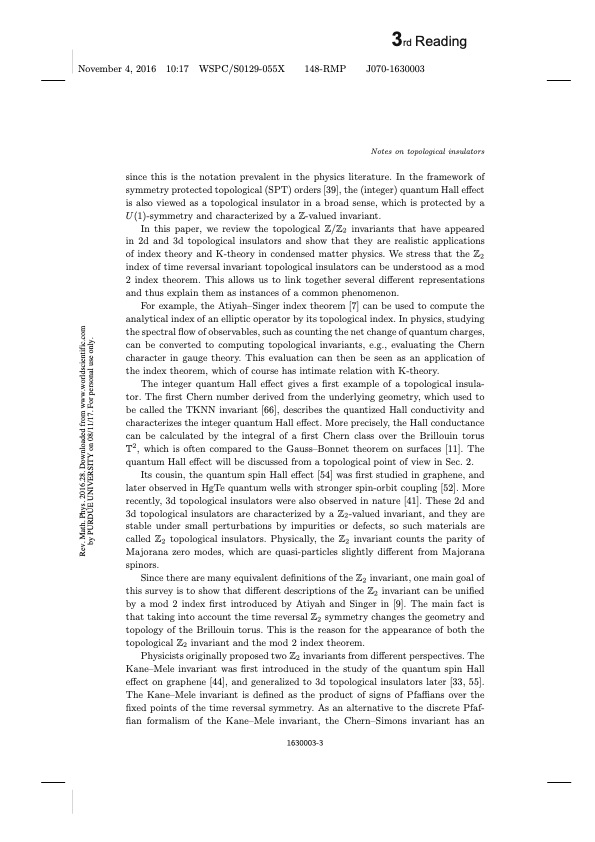
PDF Publication Title:
Text from PDF Page: 003
since this is the notation prevalent in the physics literature. In the framework of symmetry protected topological (SPT) orders [39], the (integer) quantum Hall effect is also viewed as a topological insulator in a broad sense, which is protected by a U(1)-symmetry and characterized by a Z-valued invariant. In this paper, we review the topological Z/Z2 invariants that have appeared in 2d and 3d topological insulators and show that they are realistic applications of index theory and K-theory in condensed matter physics. We stress that the Z2 index of time reversal invariant topological insulators can be understood as a mod 2 index theorem. This allows us to link together several different representations and thus explain them as instances of a common phenomenon. For example, the Atiyah–Singer index theorem [7] can be used to compute the analytical index of an elliptic operator by its topological index. In physics, studying the spectral flow of observables, such as counting the net change of quantum charges, can be converted to computing topological invariants, e.g., evaluating the Chern character in gauge theory. This evaluation can then be seen as an application of the index theorem, which of course has intimate relation with K-theory. The integer quantum Hall effect gives a first example of a topological insula- tor. The first Chern number derived from the underlying geometry, which used to be called the TKNN invariant [66], describes the quantized Hall conductivity and characterizes the integer quantum Hall effect. More precisely, the Hall conductance can be calculated by the integral of a first Chern class over the Brillouin torus T2, which is often compared to the Gauss–Bonnet theorem on surfaces [11]. The quantum Hall effect will be discussed from a topological point of view in Sec. 2. Its cousin, the quantum spin Hall effect [54] was first studied in graphene, and later observed in HgTe quantum wells with stronger spin-orbit coupling [52]. More recently, 3d topological insulators were also observed in nature [41]. These 2d and 3d topological insulators are characterized by a Z2-valued invariant, and they are stable under small perturbations by impurities or defects, so such materials are called Z2 topological insulators. Physically, the Z2 invariant counts the parity of Majorana zero modes, which are quasi-particles slightly different from Majorana spinors. Since there are many equivalent definitions of the Z2 invariant, one main goal of this survey is to show that different descriptions of the Z2 invariant can be unified by a mod 2 index first introduced by Atiyah and Singer in [9]. The main fact is that taking into account the time reversal Z2 symmetry changes the geometry and topology of the Brillouin torus. This is the reason for the appearance of both the topological Z2 invariant and the mod 2 index theorem. Physicists originally proposed two Z2 invariants from different perspectives. The Kane–Mele invariant was first introduced in the study of the quantum spin Hall effect on graphene [44], and generalized to 3d topological insulators later [33, 55]. The Kane–Mele invariant is defined as the product of signs of Pfaffians over the fixed points of the time reversal symmetry. As an alternative to the discrete Pfaf- fian formalism of the Kane–Mele invariant, the Chern–Simons invariant has an 1630003-3 Notes on topological insulators Rev. Math. Phys. 2016.28. Downloaded from www.worldscientific.com by PURDUE UNIVERSITY on 08/11/17. For personal use only.PDF Image | Notes on topological insulators

PDF Search Title:
Notes on topological insulatorsOriginal File Name Searched:
RMP.pdfDIY PDF Search: Google It | Yahoo | Bing
Sulfur Deposition on Carbon Nanofibers using Supercritical CO2 Sulfur Deposition on Carbon Nanofibers using Supercritical CO2. Gamma sulfur also known as mother of pearl sulfur and nacreous sulfur... More Info
CO2 Organic Rankine Cycle Experimenter Platform The supercritical CO2 phase change system is both a heat pump and organic rankine cycle which can be used for those purposes and as a supercritical extractor for advanced subcritical and supercritical extraction technology. Uses include producing nanoparticles, precious metal CO2 extraction, lithium battery recycling, and other applications... More Info
| CONTACT TEL: 608-238-6001 Email: greg@infinityturbine.com | RSS | AMP |